
Richard Kindersley is a British typeface designer, stone letter carver and sculptor.

Richard Kindersley is a British typeface designer, stone letter carver and sculptor.
Kindersley studied lettering and sculpture at Cambridge School of Art and in the workshop of his father David Kindersley, who was also a noted stone carver. His major public work is the Seven Ages of Man, a sculpture outside Baynard House in the City of London. [1] [2]

He has also constructed a modern stone circle called The Millennium Stones created during 1998 to 1999 in Gatton Park Surrey, to mark the double millennium from AD1 to AD2000. The first stone in the series is inscribed with the words from St John's Gospel, "in the beginning the word was". The subsequent nine stones are carved with quotations contemporary with each 200 year segment, ending with the words of T S Eliot. [3]


Sir Jacob Epstein was an American-British sculptor who helped pioneer modern sculpture. He was born in the United States, and moved to Europe in 1902, becoming a British subject in 1910.

Walter Seymour Allward was a Canadian monumental sculptor best known for the Canadian National Vimy Memorial. Featuring expressive classical figures within modern compositions, Allward's monuments evoke themes of memory, sacrifice, and redemption. He has been widely praised for his "original sense of spatial composition, his mastery of the classical form and his brilliant craftsmanship".

John Carver was one of the Pilgrims who made the Mayflower voyage in 1620 which resulted in the creation of Plymouth Colony in America. He is credited with writing the Mayflower Compact and was its first signer, and was also the first governor of Plymouth Colony.

Carrara marble, Luna marble to the Romans, is a type of white or blue-grey marble popular for use in sculpture and building decor. It has been quarried since Roman times in the mountains just outside the city of Carrara in the province of Massa and Carrara in the Lunigiana, the northernmost tip of modern-day Tuscany, Italy.

George Rayner Hoff was a British-born sculptor who mainly worked in Australia. He fought in World War I and is chiefly known for his war memorial work, particularly the sculptures on the Anzac War Memorial in Sydney.
Portmahomack is a small fishing village in Easter Ross, Scotland. It is situated in the Tarbat Peninsula in the parish of Tarbat. Tarbat Ness Lighthouse is about three miles from the village at the end of the Tarbat Peninsula. Ballone Castle lies about one mile from the village.

Baynard's Castle refers to buildings on two neighbouring sites in the City of London, between where Blackfriars station and St Paul's Cathedral now stand. The first was a Norman fortification constructed by Ralph Baynard, 1st feudal baron of Little Dunmow in Essex, and was demolished by King John in 1213. The second was a medieval palace built a short distance to the south-east and later extended, but mostly destroyed in the Great Fire of London in 1666. According to Sir Walter Besant, "There was no house in [London] more interesting than this".
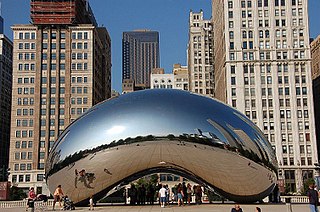
Cloud Gate is a public sculpture by Indian-born British artist Anish Kapoor, that is the centerpiece of Grainger Plaza at Millennium Park in the Loop community area of Chicago, Illinois. The sculpture and Grainger Plaza are located on top of Park Grill, between the Chase Promenade and McCormick Tribune Plaza & Ice Rink. Constructed between 2004 and 2006, the sculpture is nicknamed "The Bean" because of its shape, a name Kapoor later grew fond of. Kapoor himself even uses this title when referring to his work. Made up of 168 stainless steel plates welded together, its highly polished exterior has no visible seams. It measures 33 by 66 by 42 feet, and weighs 110 short tons.
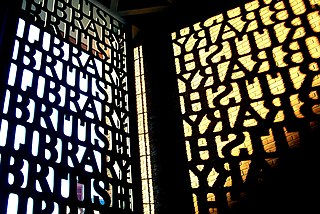
David Guy Barnabas Kindersley MBE was a British stone letter-carver and typeface designer, and the founder of the Kindersley Workshop. His carved plaques and inscriptions in stone and slate can be seen on many churches and public buildings in the United Kingdom. Kindersley was a designer of the Octavian font for Monotype Imaging in 1961, and he and his third wife Lida Lopes Cardozo designed the main gates for the British Library.
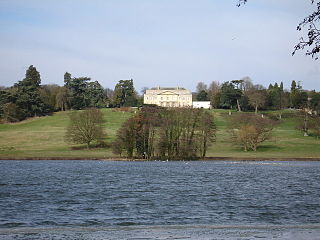
Gatton Park is a country estate set in parkland landscaped by Capability Brown and gardens by Henry Ernest Milner and Edward White at Gatton, near Reigate in Surrey, England.

John Doreward was a Serjeant-at-law and Speaker of the House of Commons of England.
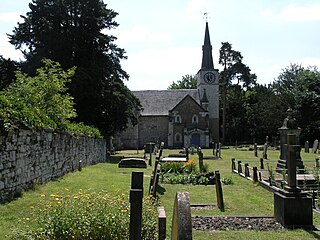
Gatton is a former village in the Borough of Reigate and Banstead, Surrey, England. It survives as a sparsely populated, predominantly rural locality, which includes Gatton Park, no more than 12 houses, and two farms on the slopes of the North Downs near Reigate.

Baynard House is a brutalist office block in Queen Victoria Street in Blackfriars in the City of London, occupied by BT Group. It was built on the site of Baynard's Castle. Most of the land under it is a scheduled monument. From 1982 to 1997 it housed the BT Museum.

Letter cutting is a form of inscriptional architectural lettering closely related to monumental masonry and stone carving, often practised by artists, sculptors, and typeface designers. Rather than traditional stone carving, where images and symbols are the dominant features, in letter cutting the unique skill is "meticulous setting out and skilled cutting of the lettering style, in terms of design, angle and depth of the lettering".
Letter carvers see the drawing and carving of letters as a particular craft in itself, allied to but distinct from masonry and carving in general. Most letter carvers are both designers and carvers. Typefaces designed for printing are rarely satisfactory when carved into stone, so most letter carvers design their own letterforms.

The California Quadrangle, California Building, and California Tower are historic structures located in Balboa Park in San Diego, California. They were built for the 1915–16 Panama-California Exposition and served as the grand entry to the Expo. The buildings and courtyard were designed by architect Bertram Goodhue. They were added to the National Register of Historic Places on May 17, 1974. They now house the Museum of Us.

Sculpture in Scotland includes all visual arts operating in three dimensions in the borders of modern Scotland. Durable sculptural processes traditionally include carving and modelling, in stone, metal, clay, wood and other materials. In the modern era these were joined by assembly by welding, modelling, moulding and casting. Some installation art can also be considered to be sculpture. The earliest surviving sculptures from Scotland are standing stones and circles from around 3000 BCE. The oldest portable visual art are carved-stone petrospheres and the Westray Wife is the earliest representation of a human face found in Scotland. From the Bronze Age there are extensive examples of rock art, including cup and ring marks and elaborate carved stone battle-axes. By the early Iron Age Scotland had been penetrated by the wider European La Tène culture, and a few examples of decoration survive from Scotland. There are also decorated torcs, scabbards, armlets and war trumpets. The Romans began military expeditions into what is now Scotland from about 71 CE, leaving a direct sculptural legacy of distance slabs, altars and other sculptures.
Fiona Leonora H. Peever, née Winkler, is a British sculptor based in Oxfordshire, England. With her husband and fellow sculptor Alec Peever, she is a director of Lettering and Sculpture Limited, a sculpture studio. She carves in stone and other materials, and has produced public art, along with art for educational and religious institutions, besides private commissions. She is known for her sculpture of Thomas Attwood in Birmingham (1993), made in collaboration with Sioban Coppinger. This statue is unusual in that it appears to have stepped down from its soapbox to sit on the steps, seemingly reading some notes.
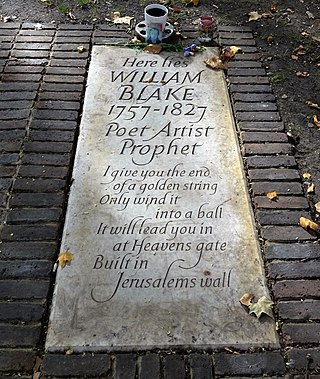
Lida Lopes Cardozo Kindersley, also known as Lida Lopes Cardozo and Lida Cardozo Kindersley, is a letter-cutter, typeface designer, author and publisher and runs the Cardozo Kindersley Workshop in Cambridge. She is considered the foremost letter-cutter currently working in the United Kingdom and is "dedicated to the increase of good lettering in the world". Her work in slate, stone and other media includes carved memorials, plaques, inscriptions and sundials which can be seen at many public locations in the United Kingdom and beyond. Her works include the ledger stone for the grave of William Blake at Bunhill Fields. With her first husband David Kindersley she also designed the main gates for the British Library.

St John's Church is a Church of England church in Tincleton, Dorset, England. It was designed by Benjamin Ferrey and built in 1849–50. The church has been a Grade II listed building since 1956.

Ray Smith (1949–2018) was an English sculptor, painter, illustrator and writer. He exhibited his work widely, and received a number awards, including an award by the Arts Council of Great Britain in 1973, and the Royal Society of Arts Architecture Award in 1993. Smith also wrote several books on art for the publisher Dorling Kindersley and designed a selection of album covers.